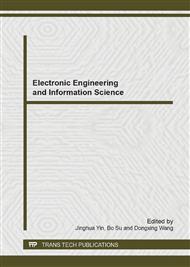[1]
T.M. Cover and J. Thomas. Elements of Information Theory, (1991).
Google Scholar
[2]
J. Jang and K.B. Lee. Transmit power adaptation for multi-user OFDM systems. IEEE Journal Selected Areas on Communication, 2003, 21(20): 171-178.
DOI: 10.1109/jsac.2002.807348
Google Scholar
[3]
W. Rhee and J.M. Cioffi. Increase in capacity of multi-user OFDM system using dynamic subchannel allocation. Proceedings of the IEEE International Vehicular Technology Conference, 2000: 1085-1089.
DOI: 10.1109/vetecs.2000.851292
Google Scholar
[4]
I.C. Wong, Z. Shen and B.L. Evans. A low complexity algorithm for proportional resource allocation in OFDMA systems. Proceedings of the IEEE International Workshop on Signal Processing Sysems, 2004: 2056-(2060).
DOI: 10.1109/sips.2004.1363015
Google Scholar
[5]
J.W. Zhang, J.X. Chi and X.R. Xv. Worst suv-carrier avoiding water-filling sub-carrier allocation scheme for OFDM-based CRN. Journal of Electronics, 2012, 3(29): 204-21.
DOI: 10.1007/s11767-012-0823-x
Google Scholar
[6]
T.T. Liu, C.Y. Yang and L.L. Yang. A low-complexity sub-carrier power allocation scheme for frequency division multiple access systems. IEEE Transactions on Wireless Communications, 2010, 9(5): 1571-1576.
DOI: 10.1109/twc.2010.5463212
Google Scholar
[7]
Y. Li, N. Lu, M.G. Peng and W.B. Wang. Multiuser Resource Allocation for OFDM Downlink with Terminal Bandwidth Limitation. Proceedings of the IEEE Wireless Communications and Networking Conference, 2010: 1-5.
DOI: 10.1109/wcnc.2010.5506208
Google Scholar
[8]
X.L. Li. A New Intelligent Optimization Method-Artificial Fish School Algorithm. Ph.D. Dissertation, (2003).
Google Scholar
[9]
Y. Li, N. Lu. Multiuser Resource Allocation for OFDM Downlink with Terminal Bandwidth Limitation. Proceedings of the 2010 IEEE Wireless Communications and Networking Conference, 2010: 1-5.
DOI: 10.1109/wcnc.2010.5506208
Google Scholar


